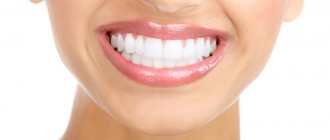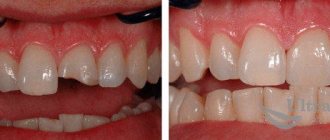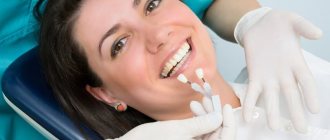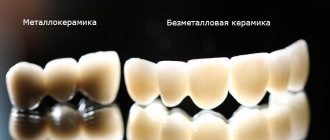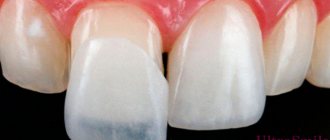Not the most common, but nevertheless occurring, dental defect is when the front teeth, the most important for the “smile line,” are different in length, and one is noticeably shorter than the other. Sometimes this is even more noticeable than the usual unevenness of the front teeth, leads to psychological discomfort and impaired diction, and in addition, it is fraught with dental health. After all, the load on the front incisors is uneven, which ultimately can lead to problems with loosening and loss of teeth.
What to do if your teeth are of different lengths, and how to fix it?
Causes of dental defects
Lengthening or shortening of one of the incisors is usually a congenital anomaly. This feature of dentition development is associated with genetic factors. Experts also include the following as possible causes of the problem:
- periodontitis,
- malocclusion,
- presence of supernumerary teeth,
- abnormal shape of the alveolar process,
- disruption of the process of resorption of the roots of baby teeth.
Changes in the length of the central incisor can also be a consequence of jaw trauma. If a tooth is mechanically damaged, its lower part may chip. Because of this, the appearance of the smile deteriorates, discomfort occurs when chewing, and the risk of developing various diseases increases.
Anomalies in the shape and size of teeth - symptoms and treatment
Anomalies in the shape and size of teeth are variations in the development of teeth and the dental system that deviate from the norm.
Malformations of the dental system are divided into major (congenital) and minor. Congenital anomalies include facial clefts, such as cleft lip, cleft palate, etc.; to small ones - anomalies in the eruption, number, shape, size and structure of teeth. Unlike congenital malformations, minor anomalies are not accompanied by significant impairments and do not threaten the patient’s life, but they significantly affect the aesthetics of the tooth and treatment tactics, and can also lead to caries, malocclusion and other complications [1].
This article describes frequently occurring minor anomalies in the shape and size of teeth: macro- and microdentia, fusion of teeth, etc. Absolute and relative indicators of their frequency and prevalence are shown in the table below [11].
| Types of anomalies | Anomaly subtypes | Frequency of anomalies in the population (%) | Prevalence of anomalies (%) |
| Size anomalies | Macrodentia | 0,42 | 0,16 |
| Microdentia | 7,87 | 3,08 | |
| Shape anomalies | Fusion and fusion of teeth | 0,21 | 0,08 |
| Taurodontism | 11,27 | 4,41 |
Subtypes of anomalies and reasons for their development
All anomalies in the shape and development of teeth can be formed under the influence of negative factors that disrupt the development of fetal tissues and organs during pregnancy. These include:
- medications;
- nutritional supplements;
- viruses;
- industrial poisons;
- alcohol;
- tobacco smoke, etc.
Macrodentia is characterized by an increase in the size of the teeth - a large crown and a tapering root. It can affect both all and individual teeth [5]. The prevalence of macrodentia in permanent teeth is 0.03-1.9%. This pathology occurs more often in men. The large size of the crown causes problems with teething and leads to deformation of the dentition [9][10].
Microdentia is characterized by the reduction of one or all teeth [6]. According to epidemiological studies, the prevalence of the anomaly ranges from 1.5% to 2%, and is more common in women than in men [19]. Teeth with this pathology usually have a cone shape.
Macro- and microdentia can be hereditary. Since the formation of follicles (buds) of permanent teeth occurs at different times, starting from the 5th month of intrauterine development and up to 3 years, the number of abnormal teeth will depend on the impact of negative factors during this period.
Taurodontism (bull tooth) refers to abnormalities in tooth shape. It manifests itself in the form of an enlarged pulp chamber - the “core” of the tooth, consisting of connective tissue, nerves, blood and lymph vessels. The base of the pulp moves closer to the apex of the tooth, and there is no narrowing at the level of the cemento-enamel junction [12].
Taurodontism can occur at any age; it is most often found in patients 13-19 years old [11]. As a rule, the anomaly does not appear before this age, since the roots of permanent chewing teeth form before the age of 13.
Dental evagination (protrusion) affects the crown of the tooth. The anomaly occurs during the period of formation and formation of tooth buds. It appears in the form of an additional tubercle that protrudes from the crown of the tooth. This tubercle consists of enamel and dentin. Its size, structure and location vary widely. It can be horny, conical or pyramidal in shape. Otherwise, such an anomaly is called a tuberculate protrusion, a claw-shaped tubercle, a Leong premolar, and an occlusal enamel pearl.
The reasons for the development of evagination are not fully understood. The influence of X-linked and autosomal dominant inheritance is assumed [2]. With X-linked inheritance, the anomaly appears only in men, and women are only carriers of the mutant gene. With autosomal dominant inheritance, boys and girls with dental evagination are born equally often, and at least one of the child’s parents also has this anomaly.
Dental invagination causes the enamel to retreat into the dental crown. Otherwise, such an anomaly is called a “tooth in a tooth.” Intussusception occurs before calcification of dental tissues during fetal development [13]. It can affect any tooth, but most often occurs on the upper lateral incisors (front teeth).
Possible consequences
Dental defects must be corrected in a timely manner. On chipped teeth, the enamel becomes thinner, so they quickly turn yellow and soon acquire a brown tint. In addition, the cracks are filled with plaque, which mineralizes and becomes a favorable environment for the growth of bacteria. Because of this, the risk of developing caries, pulpitis, gingivitis and periodontitis increases.
Congenital dental anomalies also lead to various problems. Let's list the main ones:
- speech dysfunction,
- formation of mouth breathing,
- uneven distribution of chewing load,
- development of gastrointestinal tract diseases.
To avoid serious health problems and maintain the integrity of the dentition, it is necessary to correct uneven incisors.
Why do teeth come apart?
- due to genetic predisposition;
- if the patient has a short frenulum of the upper lip;
- due to artificial feeding of a child in infancy (using a pacifier);
- due to loss of teeth due to caries, periodontal disease;
- if the germ of an erupting tooth is located between the roots of adjacent dental units;
- for malocclusions;
- due to underdevelopment of the jaw, etc.
Note! A large gap between the crowns itself can cause malocclusion.
When should you see a doctor?
Dentist help is necessary if one of the incisors is in a high or low position. In children, this defect can disappear without any intervention when replacing milk teeth with molars. If different lengths of the front teeth persist despite a fully formed bite, you should consult a doctor.
You should also contact a specialist:
- when the enamel darkens,
- increased sensitivity of teeth,
- acute toothache,
- cutter mobility,
- formation of a sharp cutting edge.
The dentist will conduct an examination, determine the cause of the problem and help solve the problem.
Types of distances between teeth
- Trema between teeth - spaces between dental units, with the exception of incisors. In this case, the pathology may not bother the patient for a long time, but it will be determined by the dentist during the examination;
- Diastema is a gap between the upper and lower incisors, which can lead to problems with pronunciation and speech in general, as well as with the aesthetics of the smile.
The distance between the front incisors, if it is not pathological, may not be treated. The most famous owners of diastemas are Vanessa Paradis, Madonna, Katy Perry and many others.
Methods for correcting front teeth of different lengths
Discrepancy in the coronal height of the central incisors can be corrected in several ways.
- Filling. Photopolymer restoration is the most affordable method of restoring the optimal length of teeth. Using composite material, you can build up the missing part of the crown.
- Wearing braces. Orthodontic treatment allows you to eliminate various defects in the dentition, including shortening and lengthening of one of the incisors.
- Installation of veneers. Ceramic or porcelain onlays replace the outer layer of teeth and provide the desired length. You can choose plates of a natural shade or snow-white.
When choosing an appropriate correction method, it is necessary to take into account the degree of deviation of the tooth height from the norm and the characteristics of the bite.
Teeth filing
If the difference in the length of the teeth is too noticeable and prominent, you can resort to filing the teeth. This procedure is performed for various deficiencies in the dentition: if the edges of the teeth are too sharp and scratch the cheeks and gums, or if the shape of the teeth is too triangular, as well as before installing crowns or veneers and before starting orthodontic treatment in some situations, the teeth are filed down to make room for further shift.
When filing (grinding) teeth, a permissible layer of enamel is removed. However, during the process, excessive sensitivity of the teeth may occur - this defect is corrected by several procedures for remineralization and fluoridation of the enamel
.
Why do you need to get rid of pathology?
Due to the rotation, the cutting part of the tooth constantly injures the mucous membranes of the cheeks and lips. In this regard, patients often suffer from recurrent stomatitis. They develop trema or diastema and have trouble biting food. Therefore, the teeth must be returned to their natural position, and this should be done as early as possible.
- Tortoanomaly usually occurs in childhood. If a child regularly visits the dentist, the pathology will be detected in a timely manner and quickly eliminated. At the milk stage and at the beginning of the formation of a mixed bite, when the jaw bones are still developing, it will not be difficult to rotate the tooth so that it takes its normal position.
- In an adult with an already formed dental system, turning around will take a lot of time. Moreover, depending on the degree of development of the pathology, even surgical intervention may be required.
What will be the consequences if the gap between the teeth is not corrected?
Will the child face consequences if the gap between the teeth is not corrected? It is impossible to answer unequivocally. During the consultation, the dentist will assess the degree of development of the diastema and correlate this with a number of other factors. However, it is impossible to accurately predict the consequences. The gap may not manifest itself in any way throughout life, but serious consequences cannot be ruled out. The diastema can expand and cause problems with bite and diction. If your child is already burring, then it makes sense to work on eliminating the diastema instead of trying to solve the diction problem with a speech therapist.
With age, the load on teeth increases, especially if they are incorrectly positioned in a row. This easily leads to caries and can cause periodontitis. An incorrect bite often results in teeth that are loose, painful, worn down, and at risk for infection and inflammation.
Therefore, in order to protect your child from frequent visits to the clinic in the future, take care of the position of his teeth today.
Why does thorotoanomaly occur?
Most often, the tooth is forced to take a pathological position due to lack of space in the jawbone due to macrodentia (large teeth in relation to the bone) or an excessively narrow jaw. In this case, it tends to turn around so as to take up as little space as possible, and the minimum will be achieved when turning at an angle of 45°. But pathology arises not only due to the primary lack of free space.
- The crown can rotate in the socket due to constant pressure exerted on it from the side or below, either by a supernumerary tooth, or by complete “neighbors” that erupt not entirely physiologically - for example, with a delay.
- Quite often, erupting permanent teeth unfold due to the persistence of the milk teeth that precede them. If during the period when baby teeth fall out, the “old” one is in no hurry to fall out, then the “new” molar will have to bypass the obstacle, deviating to the side or turning around the vertical. Pathology can be avoided by timely removal of worn-out milk teeth.
- Sometimes the cause of non-physiological tooth eruption is a dental follicle that is incorrectly formed during pregnancy or in early infancy.
- Often a permanent tooth rotates as a result of a mechanical injury received by a child at the stage of changing the primary bite to a permanent one.
